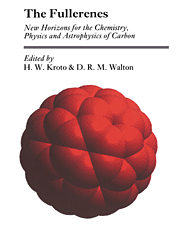Book contents
- Frontmatter
- Contents
- The evolution of the football structure for the C60 molecule: a retrospective
- Dreams in a charcoal fire: predictions about giant fullerenes and graphite nanotubes
- On the formation of the fullerenes
- Production and discovery of fullerites: new forms of crystalline carbon
- Systematics of fullerenes and related clusters
- The fullerenes: powerful carbon-based electron acceptors
- The carbon-bearing material in the outflows from luminous carbon-rich stars
- Elemental carbon as interstellar dust
- The pattern of additions to fullerenes
- Pollyynes and the formation of fullerenes
- Hypothetical graphite structures with negative gaussian curvature
- Fullerenes as an example of basic research in industry
- Deltahedral views of fullerene polymorphism
- Geodesic domes and fullerenes
Production and discovery of fullerites: new forms of crystalline carbon
Published online by Cambridge University Press: 03 February 2010
- Frontmatter
- Contents
- The evolution of the football structure for the C60 molecule: a retrospective
- Dreams in a charcoal fire: predictions about giant fullerenes and graphite nanotubes
- On the formation of the fullerenes
- Production and discovery of fullerites: new forms of crystalline carbon
- Systematics of fullerenes and related clusters
- The fullerenes: powerful carbon-based electron acceptors
- The carbon-bearing material in the outflows from luminous carbon-rich stars
- Elemental carbon as interstellar dust
- The pattern of additions to fullerenes
- Pollyynes and the formation of fullerenes
- Hypothetical graphite structures with negative gaussian curvature
- Fullerenes as an example of basic research in industry
- Deltahedral views of fullerene polymorphism
- Geodesic domes and fullerenes
Summary
Small carbon grains are assumed to be the carrier of the prominent interstellar ultra violet absorption at 217 nm. To investigate this hypothesis, we produced small carbon particles by evaporating graphite in an inert quenching gas atmosphere, collected the grains on substrates, and measured their optical spectra. In the course of this work – which in the decisive final phase was carried out with the help of K. Fostiropoulos and L. D. Lamb – we showed that the smoke samples contained substantial quantities of C60. The fullerene C60 (with small admixtures of C70) was successfully separated from the sooty particles and, for the first time, characterized as a solid. We suggested the name ‘fullerite’ for this new form of crystalline carbon.
Introduction
The production of laboratory analogues of interstellar grains was the initial aim of our research. In the autumn of 1982 while one of us (D.R.H.) was a Humboldt Fellow at the Max Planck Institute of Nuclear Physics in Heidelberg we decided to study the optical spectra of carbon grains. We felt challenged by the intense, strong interstellar ultra violet (uv) absorption at 217 nm which it had been proposed was due to graphitic grains (see, for example, Stecher 1969). The arguments in favour of such carriers are based primarily on calculations of the absorption of small, almost spherical, particles which exhibit the dielectric functions of graphite (for more recent literature see, for example, Draine 1988). There had already been very early experimental attempts to produce graphitic smoke particles by almost the same technique that we later applied to C60 production (see, for example, Day & Huffman 1973).
- Type
- Chapter
- Information
- The FullerenesNew Horizons for the Chemistry, Physics and Astrophysics of Carbon, pp. 33 - 38Publisher: Cambridge University PressPrint publication year: 1993
- 1
- Cited by



